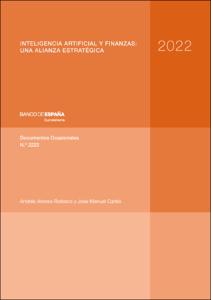Inteligencia artificial y finanzas: una alianza estratégica
Autor
Fecha de publicación
19-oct-2022
Descripción física
19 p.
Resumen
Recientes avances tecnológicos, como el almacenamiento masivo de datos y la computación en la nube, están dando lugar a un mayor uso de la inteligencia artificial en la economía y las finanzas, y modificando aspectos fundamentales tanto para entidades como para supervisores. En este documento revisamos las principales tendencias de esta transformación, especialmente el uso de algoritmos de aprendizaje automático para la predicción en entornos de incertidumbre, y detallamos algunos de los casos de uso más relevantes en la actualidad, como son la calificación crediticia, el control del fraude y la predicción macroeconómica. Para ello se utilizan en gran medida las discusiones que tuvieron lugar durante el 1.er Seminario de Inteligencia Artificial aplicada a los Servicios Financieros, organizado por el Banco de España el 17 de junio de 2022. Concluimos con una reflexión sobre la convivencia de esta tecnología con los modelos econométricos tradicionales y la necesidad de gestionar nuevos factores de riesgo asociados a su uso, como la interpretabilidad de los resultados.
Recent technological advances, such as big data and cloud computing, are leading to greater use of artificial intelligence in economics and finance, and transforming fundamental aspects of both financial institutions and supervisors. In this paper we review the main features of this transformation, especially the use of machine learning algorithms for forecasting, and we detail some of the most relevant uses of artificial intelligence today, such as for credit scoring, fraud control and macroeconomic forecasting. To this end, we make significant use of the debates that took place during the 1st conference on Artificial Intelligence applied to Financial Services, organised by the Banco de España on 17 June 2022. We conclude with a reflection on the coexistence of this technology with traditional econometric models, and the need to manage new risk factors associated with its use, such as the interpretability of the results.
Recent technological advances, such as big data and cloud computing, are leading to greater use of artificial intelligence in economics and finance, and transforming fundamental aspects of both financial institutions and supervisors. In this paper we review the main features of this transformation, especially the use of machine learning algorithms for forecasting, and we detail some of the most relevant uses of artificial intelligence today, such as for credit scoring, fraud control and macroeconomic forecasting. To this end, we make significant use of the debates that took place during the 1st conference on Artificial Intelligence applied to Financial Services, organised by the Banco de España on 17 June 2022. We conclude with a reflection on the coexistence of this technology with traditional econometric models, and the need to manage new risk factors associated with its use, such as the interpretability of the results.
Publicado en
Documentos Ocasionales / Banco de España, 2222
Materias
Aprendizaje automático; Inteligencia artificial; Finanzas; Economía; Machine learning; Artificial intelligence; Finance; Economics; Métodos Econométricos y Estadísticos; Sistema monetario y financiero. Situación y análisis
Aparece en las colecciones:












